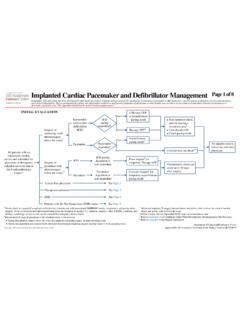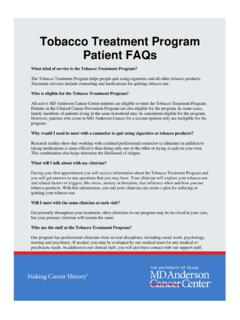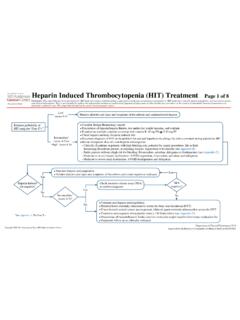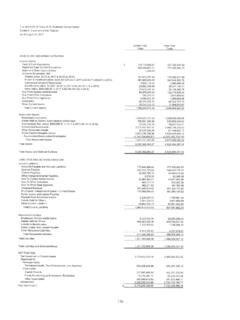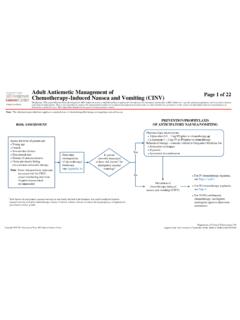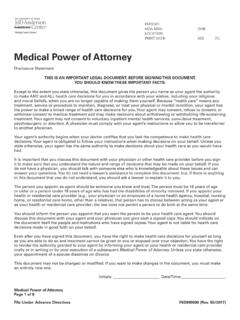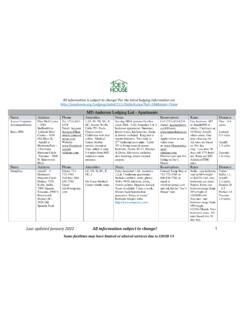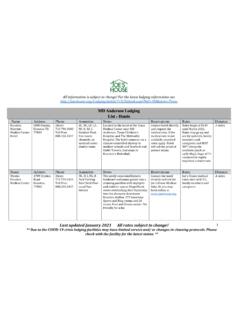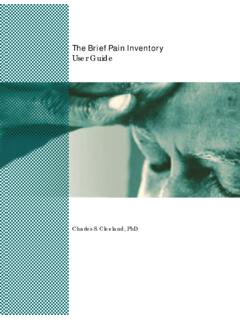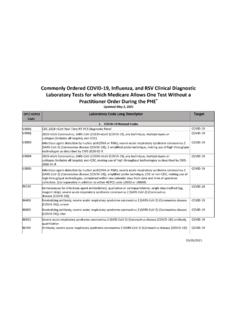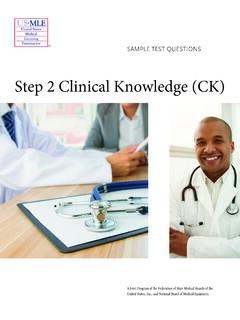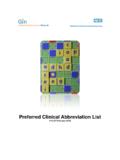Transcription of Adult Antiemetic Management of Page 1 of 22 Chemotherapy ...
1 RISK ASSESSMENTPage 1 of 22 Disclaimer: This algorithm has been developed for MD Anderson using a multidisciplinary approach considering circumstances particular to MD Anderson s specific patient population, services and structure, and clinical information. This is not intended to replace the independent medical or professional judgment of physicians or other health care providers in the context of individual clinical circumstances to determine a patient's care. This algorithm should not be used to treat pregnant Antiemetic Management of Chemotherapy -Induced Nausea and Vomiting (CINV)Department of clinical Effectiveness V7 Approved by The E xecutive Committee of the Medical Staff on 01/19/2021 Assess for level of patient risk Young age Female Non-alcohol drinker Non-steroid user History of motion sickness Those previously failing conventional Antiemetic therapyNote: These characteristics represent increased risk for CINV.
2 Closer monitoring and more frequent reassessment recommendedPREVENTION/PROPHYLAXISOF ANTICIPATORY NAUSEA/VOMITINGNote: The information provided here applies to standard doses of Chemotherapy /biotherapy not requiring stem cell of Chemotherapy -induced nausea and vomiting (CINV)Pharmacologic interventions: Alprazolam 2 mg PO prior to Chemotherapy or Lorazepam 1 2 mg IV or PO prior to chemotherapyBehavioral therapy consider referral to Integrative Medicine for: Relaxation techniques Hypnosis Systematic desensitization For IV Chemotherapy regimens, see Pages 2 and 3Is patientcurrently nauseatedor have risk factors1 for anticipatory nausea/vomiting?
3 1 Risk factors for anticipatory nausea/vomiting are not clearly defined in the literature, but could broadly be listed as: nausea/vomiting with prior Chemotherapy ; history of motion sickness; history of emesis during pregnancy or hyperemesis gravidarum; female genderDetermine emetogenicityof Chemotherapy /biotherapy(see Appendix A)NoYes For IV/PO combination Chemotherapy , use highest emetogenic agent to determine antiemetics For PO Chemotherapy regimens, see Page 4 Prevention of CINV HEC and MEC2 HEC single day ONLY:Olanzapine, serotonin antagonist (SA)3, steroid,4,5 neurokinin-1 antagonist (NKA)6 (see Page 10)HEC or MEC, single and multi-day: SA3, NKA6, steroid4,5 (see Page 12)MEC single or multi-day ONLY:SA3, steroid4,5 (see Page 13)Last day of Chemotherapy ?
4 Refer to beginningfor each day of Chemotherapy (see specific Antiemetic regimens)For subsequent cycles, see Page 6 NoYesIV Chemotherapy HIGH (HEC) AND MODERATE (MEC) RISK1IF AT ANY TIME PATIENT EXPERIENCES BREAKTHROUGH NAUSEA OR VOMITING, SEE PAGE 5 FOR MANAGEMENTPREVENTION/PROPHYLAXISHEC = Highly E metogenic ChemotherapyMEC = Moderately Emetogenic Chemotherapy1 See Appendix A for Emetogenic Potential of Chemotherapy /Biotherapy Agents2 Assess need for histamine H2 antagonist or proton pump inhibitor (PPI) for dyspepsia3 All SAs are considered therapeutically equivalent when dosed appropriately; see Appendix C (ondansetron preferred) 4 The following features of steroids should be considered in patients with hematologic malignancies prior to prescribing them as part of the Antiemetic regimen: a) risk of immunosuppression; b) avoid duplicative therapy (may already be part of Chemotherapy regimen); c) inherent activity against hematologic malignancies may mask beneficial effects of Chemotherapy in clinical trials.
5 See Appendix C for other safety Use of steroids is not recommended with cellular therapies and when immune checkpoint inhibitors are given alone. See Appendix C for more detail and other safety May interact with cytochrome P450 enzyme (CYP enzyme); check for drug interactions see Appendix CHEC or MEC, single day ONLY: Olanzapine, SA3, steroid4,5 (see Page 11) Department of clinical Effectiveness V7 Approved by The E xecutive Committee of the Medical Staff on 01/19/2021 Page 2 of 22 Disclaimer: This algorithm has been developed for MD Anderson using a multidisciplinary approach considering circumstances particular to MD Anderson s specific patient population, services and structure, and clinical information.
6 This is not intended to replace the independent medical or professional judgment of physicians or other health care providers in the context of individual clinical circumstances to determine a patient's care. This algorithm should not be used to treat pregnant Antiemetic Management of Chemotherapy -Induced Nausea and Vomiting (CINV)PREVENTION/PROPHYLAXISIV Low Risk1(10 30%)IV Minimal Risk1(Less than 10%)Prior to start of Chemotherapy : Short-acting SA3 PO or IV or Steroids4,5 PO or IV or Phenothiazine PO or IV or Prokinetic agent PO or IV(Note: Order above does not indicate preference. See Appendix C for dosing and scheduling.)Prophylactic antiemetics not required prior to the first cycle of Chemotherapy For breakthrough nausea/vomiting, see Page 5 For re-assessment/subsequent cycles, see Page 6IV Chemotherapy LOW AND MINIMAL EMETOGENIC RISK1 Prevention of CINV21 See Appendix A for Emetogenic Potential of Chemotherapy /Biotherapy Agents2 Assess need for histamine H2 antagonist or proton pump inhibitor (PPI) for dyspepsia3 All SAs are considered therapeutically equivalent when dosed appropriately, see Appendix C (ondansetron preferred)4 The following features of steroids should be considered in patients with hematologic malignancies prior to prescribing them as part of the Antiemetic regimen.
7 A) risk of immunosuppression; b) avoid duplicative therapy, may already be part of Chemotherapy regimen; c) inherent activity against hematologic malignancies may mask beneficial effects of Chemotherapy in clinical trials. See Appendix C for other safety Use of steroids is not recommended with cellular therapies and when immune checkpoint inhibitors are given alone. See Appendix C for more detail and other safety of clinical Effectiveness V7 Approved by The E xecutive Committee of the Medical Staff on 01/19/2021 Page 3 of 22 Disclaimer: This algorithm has been developed for MD Anderson using a multidisciplinary approach considering circumstances particular to MD Anderson s specific patient population, services and structure, and clinical information.
8 This is not intended to replace the independent medical or professional judgment of physicians or other health care providers in the context of individual clinical circumstances to determine a patient's care. This algorithm should not be used to treat pregnant Antiemetic Management of Chemotherapy -Induced Nausea and Vomiting (CINV)ORAL Chemotherapy EMETOGENIC RISK Prior to start of Chemotherapy :Oral short-acting SA4 Low to Minimal Risk2 (less than 30%)Prior to start of Chemotherapy : Oral phenothiazine or Oral prokinetic agent or Oral short-acting SA4(Note: order above does not indicate preference)High to Moderate Risk2 (30% or greater)RECOMMENDATIONANTIEMETIC REGIMEN For breakthrough nausea/ vomiting, see Page 5 For re-assessment/ subsequent cycles, see Page 6 Antiemetic premedications required3 No routine premedication required PRN medications recommendedfor breakthrough nausea/vomitingPatient experiences nausea/vomiting1 Assess need for histamine H2 antagonist or proton pump inhibitor (PPI)
9 For dyspepsia2 See Appendix A for Emetogenic Potential of Chemotherapy /Biotherapy Agents3 Oral continuous dosing of Chemotherapy /biotherapy for prolonged periods of time presents an emetogenic classification challenge as the emetogenic risk is likely overestimated in the product information. Therefore, an individualized approach is recommended and utilizing as needed antiemetics instead of routine premedication is often 4 All SA are considered therapeutically equivalent when dosed appropriately, see Appendix C (ondansetron preferred)Prevention of CINV1 Department of clinical Effectiveness V7 Approved by The E xecutive Committee of the Medical Staff on 01/19/2021 Page 4 of 22 Disclaimer: This algorithm has been developed for MD Anderson using a multidisciplinary approach considering circumstances particular to MD Anderson s specific patient population, services and structure, and clinical information.
10 This is not intended to replace the independent medical or professional judgment of physicians or other health care providers in the context of individual clinical circumstances to determine a patient's care. This algorithm should not be used to treat pregnant Antiemetic Management of Chemotherapy -Induced Nausea and Vomiting (CINV)Patient not able to tolerate PO or has persistentnausea/vomiting withoral antiemeticsChoose an oral agent from a class not already given that Day2,3: Phenothiazine or prokinetic agent If persistent nausea, give: short-acting SA, or atypical antipsychotic, or ABH4 combination product Consider adding steroids and/or benzodiazepine to other classes for synergy as toleratedChoose an IV agent from a class not already given that Day2,3.
